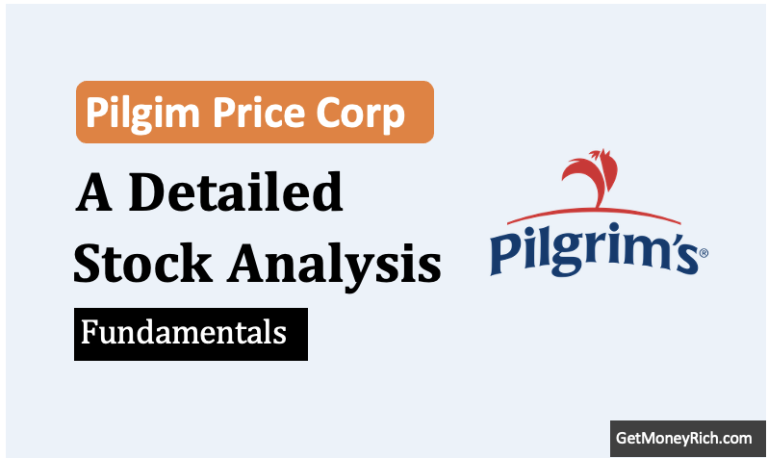In this fundamental analysis, we’ll dig deep into the financial health and performance of McKesson Corporation. This company is a prominent player in the healthcare industry. By examining key financial statements we aim to provide a comprehensive overview of the company’s profitability, growth, capital efficiency, liquidity, and solvency. This analysis covers the period from 2020 to the latest available data. This way we can do a trend assessment and identification of potential strengths and weaknesses. Additionally, we’ll also estimate the company’s intrinsic value.
The analysis will dissect profitability metrics such as Gross Margin, Operating Margin, and Net Margin to gauge the company’s ability to generate earnings from its sales. We will further examine the company’s growth trajectory by assessing Revenue Growth, EBITDA Growth, Net Profit Growth, and EPS Growth, evaluating its ability to expand its operations and increase shareholder value. Capital efficiency will be analyzed through metrics such as ROA, ROE, and ROCE, revealing how effectively McKesson utilizes its assets and capital to generate profits.
We’ll also assess McKesson’s balance sheet to determine its ability to meet short and long-term obligations. Liquidity analysis will examine the company’s current and quick ratios. Solvency analysis will analyze metrics such as the debt-to-assets ratio and interest coverage ratio.
Finally, using a discounted cash flow (DCF) model, this will help us estimate the intrinsic value of the company.
By combining these diverse elements, this analysis seeks to provide stakeholders with a holistic understanding of McKesson’s financial standing and prospects.
Business Model of McKesson Corporation
McKesson Corporation operates as a wholesale distributor of pharmaceuticals and medical supplies. They provide the products to pharmacies, hospitals, and healthcare providers.
They also offer technology solutions and business services, such as supply chain management, data analytics, and clinical support. This support help their customers improve efficiency, reduce costs, and enhance patient care.
McKesson acts as an intermediary, streamlining the flow of medications and healthcare products from manufacturers to end-users while offering additional services to support the healthcare ecosystem.
Profitability Analysis
Here is the tabulated data to complement the profitability analysis of McKesson Corporation based on the provided Income Statement data (in USD):
| Metric | 3/31/2024 | 3/31/2023 | 3/31/2022 | 3/31/2021 | 3/31/2020 |
|---|---|---|---|---|---|
| Total Revenue | $344.58 B | $308.95 B | $276.71 B | $263.97 B | $238.23 B |
| Gross Profit | $ 13.27 B | $ 12.83 B | $ 12.36 B | $ 13.13 B | $ 12.15 B |
| Operating Income | $ 4.55 B | $ 4.17 B | $ 4.58 B | $ 2.59 B | $ 3.30 B |
| Net Income (Common) | $ 2.83 B | $ 3.00 B | $ 3.56 B | $ 1.11 B | $ -4.54 B |
| Gross Margin (%) | 3.85% | 4.15% | 4.47% | 4.97% | 5.09% |
| Operating Margin (%) | 1.32% | 1.35% | 1.66% | 0.98% | 1.38% |
| Net Margin (%) | 0.82% | 0.97% | 1.29% | 0.42% | -1.90% |
- Gross Margin: The Income Statement shows Gross Profit and Total Revenue. The Gross Margin (Gross Profit / Total Revenue) provides insight into the company’s efficiency in managing its cost of goods sold. A concerning signal is a decreasing trend in Gross Profit from $13.27B to $12.15B from 3/31/2024 to 3/31/2020. As a result, the gross margin sees a dip from 5.09% in 2020 to 3.85% in 2024.
- Operating Margin: The operating margin (Operating Income / Total Revenue) reflects the company’s pricing strategy and operating efficiency. There is an increase from $4.55B to $3.30B from 3/31/2024 to 3/31/2020 in operating income. But the operating margin also sees a dip from 1.38% in 2020 to 1.32% in 2024.
- Net Margin: Net margin (Net Income / Total Revenue) indicates the company’s overall profitability after all expenses and taxes. Note that the Net Income has increased significantly from $2.83B to $-4.54B from 3/31/2024 to 3/31/2020. In terms of net margin enhance, the company has seen an uplift from 0.42% in 2021 to 0.82% in 2024.
Growth Analysis
| Metric | 3/31/2024 | 3/31/2023 | 3/31/2022 | 3/31/2021 | 3/31/2020 | CAGR |
|---|---|---|---|---|---|---|
| Total Revenue | $344.58 B | $308.95 B | $276.71 B | $263.97 B | $238.23 B | 7.66% (2020-2024) |
| EBITDA | $ 4.96 B | $ 4.68 B | $ 5.49 B | $ 2.87 B | $ -0.39 B | 14.66% (2021-2024) |
| Net Income (Common) | $ 2.83 B | $ 3.00 B | $ 3.56 B | $ 1.11 B | $ -4.54 B | 26.36% (2021-2024) |
| Basic EPS | 21.93 | 22.54 | 25.23 | 7.32 | -28.26 | 31.56% (2021-2024) |
- Revenue Growth: Based on the Income Statement, Total Revenue has increased from 3/31/2020 to 3/31/2024 (from $34.46B to $23.82B). On CAGR bases, there is a 7.66% growth.
- EBITDA Growth: Similarly, based on the Income Statement, EBITDA has increased from 3/31/2021 to 3/31/2024. (from $4.96B to $2.87B). This is happening at an impressive growth rate of 14.66% per annum.
- Net Profit Growth: Net Income from Continuing Operations increased from $2.83B to $1.11B from 3/31/2024 to 3/31/2021. The net profit has grown at a rate of 26.36% in this 4-year period.
- EPS Growth: Basic EPS increased from $21.93 to $7.32 from 3/31/2024 to 3/31/2020. In terms of CAGR growth, the compounding has happened at a massive 31.56% per annum in this 4-year period.
- Note: Though we must also note that in FY2020, the EBITDA and Net Income number was in negative.
Capital Efficiency Analysis
| Metric | 3/31/2024 | 3/31/2023 | 3/31/2022 | 3/31/2021 |
|---|---|---|---|---|
| Net Income (Common) | $ 2.83 B | $ 3.00 B | $ 3.56 B | $ 1.11 B |
| Total Assets | $ 67.44 B | $ 62.32 B | $ 63.30 B | $ 65.02 B |
| Stockholders’ Equity | $ -1.97 B | $ -1.86 B | $ -2.27 B | $ -0.02 B |
| EBIT | $ 4.31 B | $ 4.04 B | $ 4.88 B | $ 2.11 B |
| Total Liabilities | $ 69.04 B | $ 63.81 B | $ 65.09 B | $ 63.57 B |
| Capital Employed (Total Assets – Current Liabilities) | $140.87 B | $129.89 B | $128.16 B | $119.12 B |
| ROA (%) | 4.19 | 4.82 | 5.62 | 1.71 |
| ROE (%) | N/A | N/A | N/A | N/A |
| ROCE (%) | 3.06 | 3.11 | 3.81 | 1.77 |
The capital efficiency of McKesson Corporation, as measured by Return on Assets (ROA) and Return on Capital Employed (ROCE), reveals some important insights into how effectively the company is utilizing its resources to generate profits.
- ROA (Return on Assets): The ROA indicates how efficiently the company is using its assets to generate earnings. McKesson’s ROA has fluctuated over the years, with the highest value of 5.62% in 2022. This means that for every $100 of assets, McKesson generated approximately $4.19 in net income in 2024. In the last four years, the ROA of the company has improved from 1.71% (2021) to 4.19% (2024).
- ROE (Return on Equity): There is a persistent negative Stockholders’ Equity. Hence, it is impossible to calculate any meaningful data from the ROE. This is a serious issue with McKesson fundamentals.
- ROCE (Return on Capital Employed): ROCE measures how effectively a company is using its capital (debt and equity) to generate profits. McKesson’s ROCE has fluctuated over the years. For example, the ROCE value in 2024 shows that for every $100 of capital employed, McKesson generated approximately $3.06 in earnings before interest and taxes. In the last four years, the ROCE of the company has improved from 1.77% (2021) to 3.06% (2024).
The negative values of the Stockholder’s Equity presents a major problem with any meaningful capital efficiency analysis.
Balance Sheet Health
| Metric | 3/31/2024 | 3/31/2023 | 3/31/2022 | 3/31/2021 |
|---|---|---|---|---|
| Current Assets | $ 47.97 B | $ 44.29 B | $ 46.23 B | $ 45.38 B |
| Current Liabilities | $ 52.36 B | $ 47.96 B | $ 48.47 B | $ 44.10 B |
| Total Liabilities | $ 69.04 B | $ 63.81 B | $ 65.09 B | $ 63.57 B |
| Total Assets | $ 67.44 B | $ 62.32 B | $ 63.30 B | $ 65.02 B |
| Total Equity | $ -1.97 B | $ -1.86 B | $ -2.27 B | $ -0.02 B |
| Total Debt | $ 0.74 B | $ 7.30 B | $ 7.54 B | $ 9.41 B |
| Cash & Equivalents | $ 4.58 B | $ 4.68 B | $ 3.53 B | $ 6.28 B |
| Inventory | $ 21.14 B | $ 19.69 B | $ 18.70 B | $ 19.25 B |
| EBIT | $ 4.31 B | $ 4.04 B | $ 4.88 B | $ 2.11 B |
| Interest Expense | $ 0.30 B | $ 0.25 B | $ 0.25 B | $ 0.18 B |
| Liquidity Ratios | ||||
| Current Ratio | 0.92 | 0.92 | 0.95 | 1.03 |
| Quick Ratio | 0.52 | 0.51 | 0.56 | 0.60 |
| Solvency Ratios | ||||
| Debt-to-Assets Ratio | 0.01 | 0.12 | 0.12 | 0.14 |
| Leverage Ratios | ||||
| Debt-to-Equity Ratio | N/A | N/A | N/A | N/A |
| Coverage Ratios | ||||
| Interest Coverage Ratio | 14.38 | 16.04 | 19.67 | 11.83 |
The Balance Sheet provides insights into McKesson Corporation’s financial position, including its liquidity, solvency, and overall financial structure. Here’s an analysis of key metrics:
Liquidity Analysis:
- Current Ratio: The current ratio, which measures the ability of a company to meet its short-term obligations with its short-term assets, is below 1.0 for the years 2024, 2023, and 2022, at 0.92, 0.92, and 0.95, respectively, indicating that McKesson’s current liabilities slightly exceed its current assets during these periods. A current ratio of 1.03 in 2021, the short-term obligations were adequately covered by its short-term assets.
- Quick Ratio: The quick ratio, a more conservative measure of liquidity that excludes inventory from current assets, is also below 1.0 for all analyzed years, ranging from 0.51 to 0.60. This suggests that McKesson might face challenges in meeting its short-term obligations if it cannot quickly convert its inventory into cash.
Solvency Analysis:
- Debt-to-Assets Ratio: The debt-to-assets ratio is generally low, ranging from 0.01 to 0.14, which indicates that a relatively small portion of the company’s assets is financed by debt. However, it is important to note the significant amount of total liabilities compared to total assets.
- Leverage Ratio (Debt To Equity): The negative values of stockholder’s equity makes any leverage ratio meaningless.
Coverage Ratios:
- Interest Coverage Ratio: The interest coverage ratio, which measures the company’s ability to cover its interest expenses with its earnings before interest and taxes (EBIT), is robust, ranging from 11.83 to 19.67 over the analyzed years. This indicates that McKesson is comfortably able to meet its interest obligations.
McKesson’s liquidity appears to be a point of concern, as indicated by its less than optimal current and quick ratios. However, the company exhibits strong solvency, as reflected in its ability to comfortably cover its interest expenses. Investors and creditors must be aware of the current capital situation.
Cash Flow Report and Intrinsic Value Calculation (DCF)
| Cash Flow | TTM | 3/31/2024 | 3/31/2023 | 3/31/2022 | 3/31/2021 |
|---|---|---|---|---|---|
| Free Cash Flow | $1.634B | $3.627B | $4.601B | $3.899B | $3.901B |
- Free Cash Flow (FCF): The Free Cash Flow for the TTM (Trailing Twelve Months) is $1.634B
Assumptions:
- Growth Rate (Next 5 Years): 10%
- Terminal Growth Rate: 3%
- Discount Rate: 8%
Future Free Cash Flows and Their Present Value:
| Year | FCF (in $B) | Growth Rate | Discount Factor | Present Value of FCF (in $B) |
| 0 | 1.634 | |||
| 1 | 1.797 | 10% | 0.926 | 1.664 |
| 2 | 1.976 | 10% | 0.857 | 1.693 |
| 3 | 2.174 | 10% | 0.794 | 1.726 |
| 4 | 2.391 | 10% | 0.735 | 1.757 |
| 5 | 2.630 | 10% | 0.681 | 1.791 |
Terminal Value and Its Present Value:
| Terminal Value Calculation | – |
|---|---|
| Terminal FCF (Year 6) | 2.709 |
| Terminal Growth Rate | 3% |
| Discount Rate | 8% |
| Terminal Value | $54.18 B |
| Present Value of Terminal Value | $36.89 B |
Sum of Present Value of All Future Cash Flows
| Sum of Present Values of FCF (Years 1-5): | $ 8.63 B |
|---|---|
| Present Value of Terminal Value (Year 5): | $36.89 B |
| Intrinsic Value of the Company: | $45.52B |
Intrinsic Value Per Share Calculation
| Shares Outstanding | 0.12533 B |
|---|---|
| Intrinsic Value per Share | $363.26 |
Based on the discounted cash flow (DCF) analysis using the specified assumptions, the estimated intrinsic value of McKesson Corporation is $363.26 per share. It significantly lower than the current market price of $627 per share.
This suggests that, according to this particular DCF valuation, McKesson’s stock may be overvalued by the market.
Conclusion
Negative Equity: The consistently negative Stockholders’ Equity on the Balance Sheet is a major red flag and requires further investigation to understand the underlying cause. This could significantly distort many financial ratios and impacts the overall understanding of the company’s fundamentals.
Personally speaking, I would think hundred times investing in a company whose shareholder’s equity remains negative for 4-5 years all together.
Having said that, I’ll also say that barring the negative equity profile, the company looks to be of a fairly strong fundaments (high growth, low profitability, and low returns).
Intrinsic Value: The company looks very overvalued looking at my DCF Analysis.
Overall, McKesson Corporation is such a company whose shares I’ll not buy immediately. The main concern is its negative shareholder’s equity and low intrinsic value (compared to its current price). But if, for a moment, I do not look at my DCF estimation, the current valuation metrics looks dear. PEG of 1.04 cannot be ignored.
| Metrics | Current | 12/31/2024 | 9/30/2024 | 6/30/2024 | 3/31/2024 | 12/31/2023 |
|---|---|---|---|---|---|---|
| Trailing P/E | 27.79 | 29.48 | 22.1 | 26.08 | 24.27 | 18.31 |
| Forward P/E | 16.5 | 15.82 | 15.46 | 18.42 | 17.36 | 15.08 |
| PEG Ratio (5yr) | 1.04 | 1.06 | 1.43 | 3.23 | 5.11 | 4.87 |
| Price/Sales | 0.23 | 0.23 | 0.21 | 0.25 | 0.24 | 0.22 |
Hence, for a moment I’ll add this stock to my watch list. A major correction like 30%+ will make it a value buy.
Have a happy investing.






